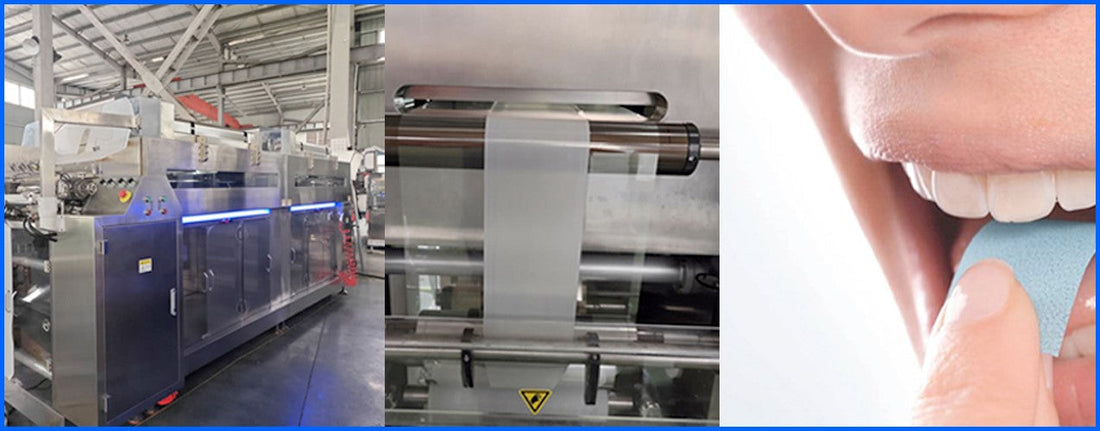
How oral dissolving film strips are made
Share
Growth in the ODF market
Oral dissolving film strips, ODFs, have been established as a viable option for the administration and delivery of both pharmaceutical and non-pharmaceutical products. And the market for them is continuing to grow, at an estimated annual rate of nearly 10%, for the next 5 to 7 years.
Oral dissolving film strips, ODFs, have been established as a viable option for the administration and delivery of both pharmaceutical and non-pharmaceutical products. And the market for them is continuing to grow, at an estimated annual rate of nearly 10%, for the next 5 to 7 years.
Both need and demand are increasing from all professional and consumer sectors — medical, retail, and E-commerce. In light of this increased growth, the ODF market is benefitting from trends in thin film formulations, advances in polymer-based strip engineering, and demand for on-the-go therapeutics for everything from allergy relief to wellness applications, nutraceuticals and supplements, and even the food industry.
The coupling of consumer acceptance and preference for better formulations of the substances being administered, and advancements in manufacturing technology are all part of the support behind the growth.
With the increase in popularity has also come a long list of names by which the strips are referred to. For example, depending on the source, they are called:
- oral dissolving films (ODF)
- oral dissolving strips (ODS)
- orally disintegrating strips (also ODS)
- oral dispersible thin films (ODTF)
- oral thin films (OTF)
- oral fast-dissolving films (OFDF)
- fast dissolving films (FDF)
- oral fast dissolving strips (OFDS)
- dissolving oral film strips (DOFS)
- dissolving oral thin films (DOTF)
Did we miss anything? The point is, all the names refer to a product that accomplishes the same thing: The film strips are an ideal intraoral, fast-dissolving delivery system for both pharmaceutical and non-pharmaceutical applications. The names are interchangeable in that sense.
Riize Health has been a leader and early innovator in the use of highly effective oral film strips for the treatment of erectile dysfunction (ED) and overall sexual health and self-care, and has now been established as a leader in non-pharmaceutical supplement products, including for energy, sleep, digestion, motion sickness and hangovers, just to name a few.
All Riize strip products are state of the art in both formulations and manufacturing. Despite their obvious benefits, earlier generations of oral film strips were limited in their stability and the dosage amounts they could reliably deliver. However, innovations in drug formulas and manufacturing technology changed that.
What are oral dissolving strips made of?
ODFs are composed of single or multiple polymer-based layers. The dose of the active or therapeutic ingredient is controlled by the size and thickness of the film. The active ingredient is either dissolved or held in suspension in the polymer material in the manufacturing process. Recently, new techniques have been developed to deal with solubility differences in the active ingredients being used, including nanoparticle technology to reduce particle size.
To create effective ODFs, the right combination of ingredients must be formulated. The main ingredients include:
- Water-soluble polymers. These form the film itself and can make up to 50% of the formula combination. They are what give the film a good mouth feel and allow for rapid disintegration. Common choice are hydroxypropyl methylcellulose (HPMC), polyvinyl alcohol (PVA), pullulan, sodium alginate and carboxymethyl cellulose (CMC).
- Active ingredient. Whether pharmaceutical or non-pharmaceutical, as in the case of supplements, the active ingredient typically makes up between 1% and 30% of the composition. It must be compatible and stable when interacting with the polymer.
- Plasticizers. Compounds like glycerin, polyethylene glycol (PEG), propylene glycol, sorbitol or castor oil are used to allow for increased flexibility, elongation and tensile strength in the film during the manufacturing process. They can make up anywhere from 1% to 20% of the composition, depending on the mechanical needs of the particular formula.
- Saliva stimulating agents. Things like citric acid or malic acid are used to increase the rate of saliva production and help with faster disintegration of the film. They can make up 2% to 6% of the film's weight.
- Sweetening and flavoring agents. These obviously enhance the palatability of the strip by appealing to the sense of taste. They typically make up 6% to 10% of the composition and include things like aspartame, sucralose and natural flavors.
How are oral dissolving film strips (ODFs) made?
Multiple active ingredients can now be layered in one strip, in high concentrations, with a minimal amount of excipient ingredients added. Both water-soluble and insoluble active ingredients can be integrated in the same film, some with different absorption profiles. There have also been advancements in extended-release formulations, as well as enhancements for taste.
There are four main ways in which oral dissolving film strips are manufactured. By far the most common (over 90%) is solvent casting due to its scalability and process stability.
Solvent Casting.


The main steps for solvent casting are: preparation of the casting solution, deaeration (to remove air bubbles), casting, drying, cutting and slitting and packaging. In this process, the water-soluble ingredients are dissolved into one clear solution with high viscosity. The drug ingredient, along with other excipients are dissolved into a solvent. Both solutions are then mixed and dried onto a petri surface, from which they are removed and cut to size. Solvent casting is an easy preparation process with low processing costs, and produces maximum uniformity in film thickness.
Lesser-known and used manufacturing methods include:
Hotmelt extrusion.
The process is similar to those used in the plastics manufacturing sector, relying on heat and lack of solvents to create molten materials which are then forced through an orifice and allowed to cool. It has been used mostly for transdermal products as well as sustained release tablets and granules.
Solid dispersion.
The drug is dissolved in an appropriate liquid solvent, then mixed into a polyol melt, such as polyethylene glycol, without eliminating the liquid solvent. As it cools, the components are forced through dies to create the structure of the film. A common disadvantage is that the drug solvent won't mix well with the melted polyethylene glycol.
Rolling method.
In this process, a pre-mix is first prepared, then the active ingredient is added. It has to go through a series of steps to mix and form the film from a homogenized matrix of all the substances.
Quality control in ODF manufacturing
ODFs require high precision due to their small size and thin structure. During the manufacturing process they are routinely tested for uniformity in film thickness and active ingredient content, disintegration time, tensile strength, flexibility, folding endurance, moisture control and microbial limits.
Riize oral dissolving film strips are manufactured with the latest in thin-film technology to ensure that is meets or exceeds all these standards, as well as providing the maximum effectiveness of the active drug or supplement being administered.
Future growth in ODF manufacturing
Among the avenues still being explored for rapid drug release products, oral film strip technology is at the forefront of continuing research and development. For example insoluble active ingredients can now be integrated in the same film, some with different absorption profiles. There have also been advancements in extended-release formulations, as well as enhancements for taste.
The ODF market, which has increased by approximately 80% in the last ten years, will continue to advance the technology needed to keep ODFs as a versatile, scalable and user-friendly option for pharmaceutical and non-pharmaceutical administration.
SOURCES
- https://www.iomcworld.org/articles/fast-dissolving-films-a-novel-approach-to-oral-drug-delivery.pdf
- https://journals.innovareacademics.in/index.php/ijpps/article/view/50386/29921
- https://www.verifiedmarketreports.com/product/orally-disintegrating-films-odfs-market
- https://www.researchgate.net/figure/Solvent-casting-technique_fig2_305471778
- https://www.researchgate.net/figure/Solvent-casting-technique-Advantages-1-Better-uniformity-of-thickness-and-better_fig1_309134813
- http://pharmacy-machines.com/1-2-1-ozm-film-making-machine.html
- https://www.ncbi.nlm.nih.gov/pmc/articles/PMC3757902/
-
https://www.odfsolution.com/ozm-340-automatic-oral-thin-film-making-machine-product/
- http://pharmacy-machines.com/1-2-1-ozm-film-making-machine.html
-
https://en.wikipedia.org/wiki/Thin-film_drug_delivery
- https://pmc.ncbi.nlm.nih.gov/articles/PMC10439052/
- https://pmc.ncbi.nlm.nih.gov/articles/PMC10747242/
- https://agnopharma.com/technical-briefs/dissolving-films/
- https://ijcrt.org/papers/IJCRT2201131.pdf



